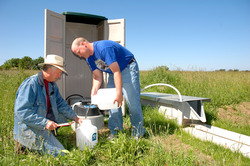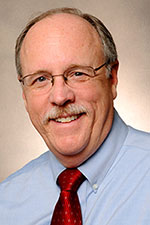Researchers document reduced poultry litter application in watersheds

Contact Information:
 Andrew Sharpley, Daniel Department of Crop, Soil, and Environmental Sciences
Andrew Sharpley, Daniel Department of Crop, Soil, and Environmental Sciences
479-575-2354 / sharpley@uark.edu
 Dr. Tommy Daniel, Department of Crop, Soil, and Environmental Sciences
Dr. Tommy Daniel, Department of Crop, Soil, and Environmental Sciences
 H.L. Goodwin, Dept. of Agricultural Economics and Agribusiness
H.L. Goodwin, Dept. of Agricultural Economics and Agribusiness
479-575-2256 / hlgood@uark.edu
By Howell Medders,
Division of Agriculture, University of Arkansas System
479-575-5647 / hmedders@uark.edu
FAYETTEVILLE, Ark. — Farmers in a northwest Arkansas and northeast Oklahoma watershed have reduced their use of poultry litter for pasture fertilizer by 75 percent since 2003, according to the University of Arkansas System Division of Agriculture team that has helped farmers develop and implement 'nutrient management plans' on their farms.
The Eucha-Spavinaw watershed in Benton County in Arkansas and Mayes and Delaware counties in Oklahoma feed into lakes used by municipal water systems and for recreation. Changes in the management of poultry litter and other sources of nutrients added to the watersheds were agreed to in a 2003 settlement of a lawsuit by the City of Tulsa against selected poultry companies, municipalities and others.
To help implement the settlement, a team of advisers was assembled with support from the Arkansas Natural Resources Commission and the Oklahoma Conservation Commission.
For three years Tommy Daniel, University of Arkansas professor of crop, soil, and environmental sciences, led a Division of Agriculture team to create the Eucha-Spavinaw Phosphorus Index (ESPI), which has been used to develop nutrient management plans for farmers since 2003.
"A great deal of science and research went into developing and supporting ESPI," Daniel said. "We had to make the index extremely rigorous and scientifically sound so that farming in this area could remain economically sustainable, yet be environmentally responsible."
The ESPI tool assesses the risk of phosphorus runoff by considering such factors as the amount of phosphorus in soil as determined through soil testing, the amount and timing of manure applications, the probability of runoff and soil erosion, and pasture and grazing management, Daniel said.
More recently, other members of the Division of Agriculture -- Andrew Sharpley, professor of crop, soil, and environmental sciences; Mike Daniels, a Cooperative Extension Service nutrient management specialist; Brian Haggard, director of the Arkansas Water Resources Center; and H.L. Goodwin, professor of agricultural economics, have studied results to see what changes have occurred in the watershed.
"ESPI is used by farm advisers in the Eucha-Spavinaw watershed to determine how much litter can be applied to pastures and keep the risk of phosphorus runoff low," Sharpley said. "A similar approach is now used in 47 states."
"During the past five years, ESPI has been used exclusively to develop nutrient management plans that guide poultry litter applications to pastures within the watersheds," Mike Daniels said. "From these plans, an extensive and detailed database has been developed on nutrient management. Such a large-scale database does not exist anywhere else in the world. The database is providing researchers with insight and verification that was not possible before."
Based on this database, a research paper, "Outcomes of phosphorus-based nutrient management in the Eucha-Spavinaw watershed," by Sharpley, Daniel and others is being published in the proceedings of a conference, "Farming with Grass: Sustainable Mixed Agricultural Landscapes in Grassland Environments," sponsored by the Soil and Water Conservation Society in Oklahoma City in October 2008. Other research papers have been published in the Journal of Environmental Quality and Journal of Soil and Water Conservation on the management of poultry litter under lawsuit settlement agreements in this watershed.
The 75 percent reduction in land application of poultry litter in the watersheds over the last four years, as documented in the ESPI database, is twice the reduction called for in the settlement, Sharpley said.
Haggard has been studying water quality in the Eucha-Spavinaw watershed since 1998. As required by the settlement, one rural municipal wastewater treatment plant has significantly reduced phosphorus levels in its effluent discharge, he said. The phosphorus concentrations downstream from this effluent discharge have significantly decreased in the last several years.
The Oklahoma Conservation Commission in a recent press release reported "continual improvement in water quality in Beaty Creek within the Eucha-Spavinaw watershed." The commission said water quality monitoring data show a 66 percent reduction in phosphorus loading into Beaty Creek in Delaware County, where "best management practices" (BMPs) had been implemented on farmland as part of demonstration projects, compared with a nearby stream that had no BMPs.
Mike Daniels said, "The use of ESPI in plan development has reduced the average poultry litter application from 1.5 tons per acre in 2004 to 1.2 tons per acre in 2007. Before 2003 and before the use of ESPI, the common practice in Arkansas was to spread enough poultry litter to supply the nitrogen requirements of pasture, which may have been between 3 and 5 tons/acre on average."
Poultry litter has long been used as an economical source of nitrogen and other nutrients for pastures and other crops. However, application rates that meet nitrogen requirements of plants may provide an excess of phosphorus, which can build up in the soil and eventually run off into steams. Too much phosphorus can accelerate growth of algae and other water quality problems, Sharpley said.
H.L. Goodwin, an agricultural economist with the Division of Agriculture, puts the overall cost to farmers of litter management changes in the watershed at $6.25 million since the settlement. The cost is primarily due to the loss in nitrogen value from reduced use of litter, but includes loss in the liming effect of litter.
Goodwin's analysis credits the sale of litter exported from the watershed to farmers in areas where soils do not contain excess phosphorus. But returns from litter sales are well below the actual value of nitrogen contained in the litter as compared to equivalent amounts of commercial fertilizer, he said.
The average soil test phosphorus level of all agricultural fields within the Eucha and Spavinaw watershed has remained stable at around 175 parts per million (230 lbs/acre) since 2004, Daniel said. Soil levels are measured by soil testing laboratories in Arkansas and Oklahoma to guide farmers as to nutrient levels needed by their crops, he said.
"Because phosphorus bonds strongly with soil, and pastures don't remove a great amount of phosphorus each year, it is not uncommon for these levels to take several years to decline," Sharpley said. However, he added, "95 percent of farmlands for which plans were written had soil test phosphorus values below the settlement imposed cut-off of 300 parts per million of phosphorus or 400 pounds of phosphorus per acre."
"With such evidence from Oklahoma and Arkansas, we feel that the plan-writing process and use of ESPI has led to more restrictions on where, when and how much poultry litter can be applied to pastures," Sharpley said. "Basically, use of ESPI met the strict requirements of the lawsuit settlement agreement, and it is apparent that it reduced the application of poultry litter in the Eucha-Spavinaw Basin."
This reduction in poultry litter application and the implementation of BMPs will result in improved water quality within this basin, Brian Haggard said. He added that the effects of reduced phosphorus runoff might not be visible in streams and lakes in the short term, because of phosphorus stored within the stream channel, especially downstream from the historic contributions of the effluent discharge.
"Like all watersheds, there are many sources of phosphorus, and past management can leave a legacy that is slow to change," Sharpley said; "however, we are seeing that the use of ESPI and the advice farmers are getting are making a difference by decreasing phosphorus runoff and achieving an appropriate balance between water quality and economic vitality of farming in the watershed."